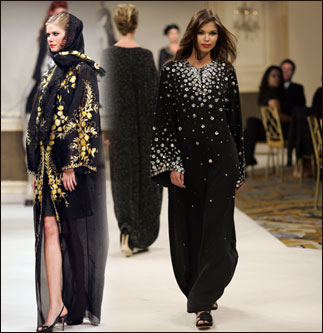|
|
| |
foreign
editorial
Abaya gets a makeover from John Galliano and Blumarine
Top European fashion labels, including John Galliano and Blumarine, have sent models in couture abayas down the runway in an effort to lure wealthy Muslim women to their brand.
|
| |
A horsewoman in a flowing, made-to-measure Islamic gown atop a snorting steed opened the fashion show last week at the George V Hotel in Paris.
Abayas are the body-covering black robes some Muslim women don over their clothing in public, usually accompanied by a head scarf or niqab, the face veil that covers all but the eyes.
Designers who tried their hand at making over the abaya, which is required in Saudi Arabia, included Christian Dior's artistic director John Galliano, French luxury labels Nina Ricci and Jean Claude Jitrois and Italian houses Blumarine and Alberta Feretti.
The show began with a bang, as the carrot-topped cavaliere - decked out in a Galliano-designed abaya exploding with firework of coloured sequins and dangling fringe - rode her mount into the hotel's subterranean salon. |
 |
|
| |
Twenty models followed on foot, wearing abayas heavy with rhinestones or airy in gauzy fabrics.
"I realised that most of the Saudi clients are wearing designer brands, but they're covered by a black abaya," said Dania Tarhini, the show's organiser and a general manager of Saks Fifth Avenue in Saudi Arabia. "It is an obligation to wear the abaya there, but let them feel good about it."
The timing of the Paris show was propitious: four days earlier, Nicolas Sarkozy, the French president, struck a nerve in the Muslim world by declaring that full-body veils such as the burka are "not welcome" in France, saying they make women prisoners. A top Muslim group in Britain called Mr Sarkozy "patronising and offensive." Lebanon's most influential Shia cleric called on Mr Sarkozy to reconsider his comments.
Ms Tarhini, a Lebanese who has lived in Saudi Arabia for the past seven years, acknowledged "it wasn't easy" to convince designers to take part in the project.
At first, "they couldn't imagine how to make a designer abaya," she told the Associated Press in an interview. "I explained to them the concept is to (make women) look good and also to promote their brands....then they accepted."
|
| |
She said the initial batch of made-to-measure abayas - worth between €4,000-€8,000 ($5,500-$11,150) - would be given as presents to Saks' most faithful Saudi clients.
Ready-to-wear versions of the robes by the 21 designers featured in the Paris show are expected to go on sale in Saks stores the Saudi Arabian cities of Jeddah and Riyadh in September. The gowns, which are to retail for 1,800 ($2,500), could later be sold in the store's branches in neighbouring Bahrain and Dubai, she said.
Most of the gowns on display adhered to standards considered appropriate for wear in Saudi Arabia: all were black, most were floor-length and many had a built-in head covering or matching veil.
|
 |
|
| |
The few translucent abayas, like a bell-sleeved gown embroidered with white and yellow flowers by Carolina Herrera, the Venezuelan designer favoured by Renée Zellwegger, were meant to be worn over evening gowns, Ms Tarhini said.
"Everybody's waiting for a change in a good way," she said. Some women in Saudi Arabia "don't want to feel obliged (to wear the abaya). They want to wear it to look fashionable, as well."
– Courtesy: The Telegraph |
| |
|

